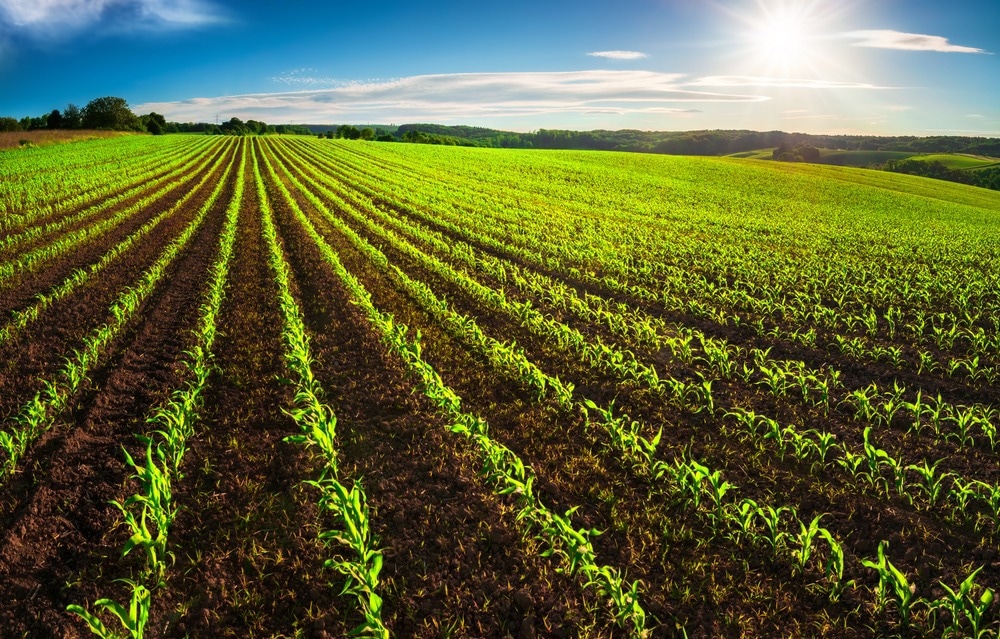Technological innovations have provided modern agriculture with diverse tools and techniques to optimize agricultural practices. Precision agriculture is of particular significance as the integration of technologies has allowed more sustainable management strategies without sacrificing productivity.

Image Credit: Smileus/Shutterstock.com
A Paradigm Shift in Food Production: How Technology Revolutionized Agriculture
Technological innovations over the last century have transformed every facet of human life, from media digitization to industrial factory production and agriculture. Advances in information and communication technologies (ICT) have led to dramatic shifts in every area they have been applied to, particularly agriculture. Growing human populations depend on sufficient food production to maintain such growth, and agricultural productivity has had to adapt to meet the demands for food.
As technologies have become increasingly more powerful, efficient, and multipurpose, their applications in agriculture have provided solutions to numerous challenges. In recent decades, breakthroughs in drone technology, imagery, satellite data, and smart technologies have proven particularly useful for agricultural producers to address environmental, societal, and technological issues.
The changes induced by ICTs were so impactful that modern agriculture has experienced a shift towards managing agricultural production using sustainable, technology-dependent, and increasingly broad-scale methods.
Precision agriculture (PA), which refers to the management of crops and livestock using evidence-based approaches to optimize productivity, has become a common strategy worldwide. Specifically, PA relies on a process of observation, measuring, and responding, to changes affecting productivity, with the objective of using the least amount of resources to obtain the maximal outcome. Moreover, technology plays critical roles throughout each step of the process, as data sensors, remote sensing, and machine learning can all inform the decision-making process by supplying real-time data.
The implications for PA were discussed in a review by Cisternas et al. (2020), in which authors explore the benefits, drawbacks, and technologies used. Nearly 4,000 publications considering PA were found by authors in the initial review, of which nearly 300 fit the scope of their question. The majority of the studies considered found that PA increased productivity, and the most commonly used technology was remote sensors, yet no clear frameworks were laid out to structure the results or technologies.
Challenges and Solutions to Precision Agriculture
The same review by Cisternas et al. (2020) also discussed the challenges facing PA. Authors highlight that despite widespread implementation, PA faces various issues from onset to outcome that limit its applicability. PA has many challenges to overcome, from finances to technology dependence, before becoming the global standard.
For instance, the initial financial investment to implement PA technologies and procedures is considerable, and although PA is a long-term investment, the funding and training required are extensive. The learning of IT skills to operate PA technologies is also limiting, as stakeholders require licenses, appropriate computational skills, and experience with software and hardware in order to manage PA techniques. A minimum of knowledge is therefore required before even considering the implementation of PA.
As a result of the required knowledge and financial costs, the adoption of PA has remained below expectations over the last decade. To solve such limitations, researchers have attempted to facilitate the use of technologies while policymakers have focused on subsidizing many of the technologies to limit the elevated operation expenses. Together, these solutions have alleviated some of the burdens for stakeholders in usage difficulty (e.g., making easy mobile or computer applications) and financial burden (e.g., providing loans, regional investments, discounted operations, and training).
The Future of PA; Addressing Food Demands and Further Technological Incorporations
The potential applications of PA to address rising food demands were further discussed by Zhang et al. (2002). Asia remains the fastest-growing continent, with Asian populations requiring the most food to supply the largest populations on earth. The authors highlight how PA may be particularly suited to address such demand for productivity and how systems may be able to address the spatial and temporal variability of soil and crop factors as well as socioeconomic limitations that manual labor typically brings.
Although PA provides numerous benefits for stakeholders, its limitations may affect its applicability, particularly in developing areas that lack the training or financial capacities to implement them. Nonetheless, the core principle that PA can help maximize resource use while minimizing losses and waste will be critical in a world experiencing changing environmental conditions. The effectiveness of PA will also be further improved through the continued integration of automated and digital technologies that are gradually becoming cheaper, more effective, and possess multiple applications.
The transformation of agricultural production from manual, industrial, monocultural-based practices towards more sustainable and technological-based agriculture will benefit longer-term food production. In the coming decades, the maintenance of food security will remain of primary concern worldwide, and strategies relying on low-input but highly efficient systems, such as PA, will be valuable to support the necessary policies.
Sources
- Akhter, R., & Sofi, S. A. (2021). Precision agriculture using IoT data analytics and machine learning. Journal of King Saud University - Computer and Information Sciences, 34(8), 5602–5618. https://doi.org/10.1016/j.jksuci.2021.05.013
- Bwambale, E., Abagale, F. K., & Anornu, G. (2022). Smart irrigation monitoring and control strategies for improving water use efficiency in precision agriculture: A review. Agricultural Water Management, 260, 107324. https://doi.org/10.1016/j.agwat.2021.107324
- Cisternas, I. S., Velásquez, I., Caro, A., & Rodríguez, A. O. (2020). Systematic literature review of implementations of precision agriculture. Computers and Electronics in Agriculture, 176, 105626. https://doi.org/10.1016/j.compag.2020.105626
- Zhang, N., Wang, M., & Wang, N. (2002). Precision agriculture—a worldwide overview. Computers and Electronics in Agriculture, 36(2–3), 113–132. https://doi.org/10.1016/s0168-1699(02)00096-0
Further Reading
Last Updated: Aug 31, 2023